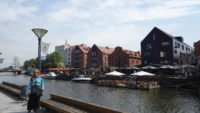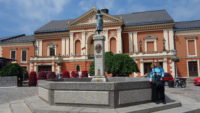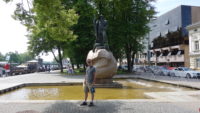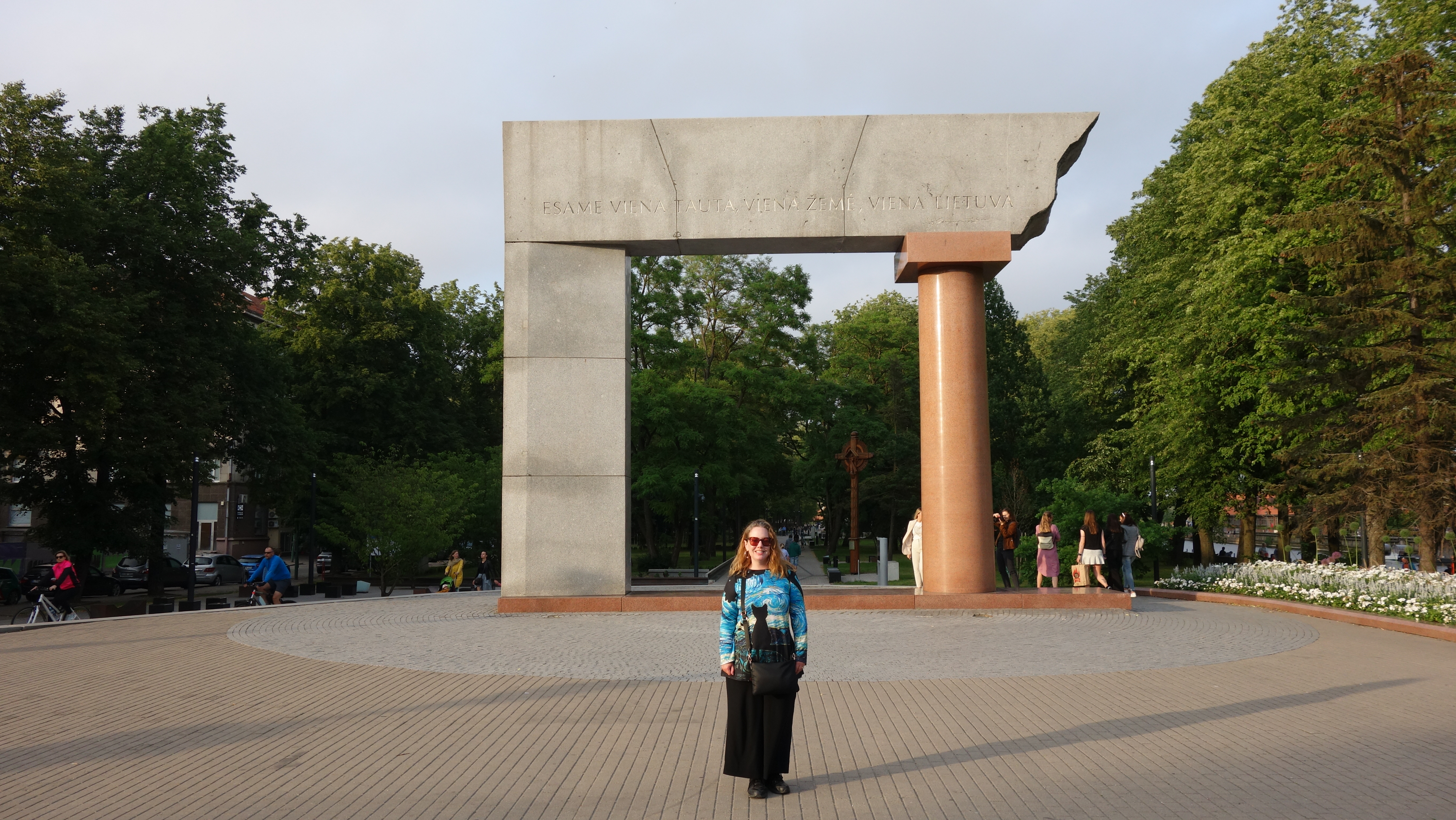 Collect them all! Having been to Lithuania’s first, second, and fourth biggest cities (Vilnius, Kaunus, and Siauliai), we added the third biggest city today – Klaipeda, which is only about thirty minutes south of Palanga, where we were last night. Combining the fact that Klaipeda is Lithuania’s only seaport and that it has a population of about 200,000 people, I wasn’t sure what to expect.
Collect them all! Having been to Lithuania’s first, second, and fourth biggest cities (Vilnius, Kaunus, and Siauliai), we added the third biggest city today – Klaipeda, which is only about thirty minutes south of Palanga, where we were last night. Combining the fact that Klaipeda is Lithuania’s only seaport and that it has a population of about 200,000 people, I wasn’t sure what to expect.
It turned out to be a great town, once I ditched the car at the hotel. Our hotel is on the edge of the Old Town, which is on the river, and the river area is pedestrian-centric, with walking paths on both sides of the river, and with wide sidewalks on the main roads, and the Old Town itself has cobblestone streets that keep cars either slow or away. There are restaurants all along the river area toward the sea, and people were out and about today (although some of that may have been from its being a workday).
Once we got checked into the hotel around noon, we went out in search of lunchfast again. Thank goodness our Klaipeda hotel has breakfast, so we can get on a more normal eating schedule again tomorrow. Mer took us to a restaurant in the Old Town that was next to a large square. While we were waiting for our food, we heard a loud drumbeat for several minutes, then a bass, then horns, and finally vocals. There was going to be a concert in the square at 9:00 tonight, and the band was doing a sound check. They had decided to do swing music, which was tons of fun. We hung out in the square for a couple of songs after we had finished eating, just listening.
 Mer took us out of the Old Town, and headed down a street lined with three-story buildings. We stopped in front of a set of stairs and went in. Mer had brought me to the Klaipeda Clock Museum. It was about time! We had actually wanted to see a watch and clock museum last year in Waterford, Ireland, but we ran out of time, so now we got to see Lithuania’s version.
Mer took us out of the Old Town, and headed down a street lined with three-story buildings. We stopped in front of a set of stairs and went in. Mer had brought me to the Klaipeda Clock Museum. It was about time! We had actually wanted to see a watch and clock museum last year in Waterford, Ireland, but we ran out of time, so now we got to see Lithuania’s version.
We got an audioguide, which is always useful when the written information in the rooms is in Lithuanian. The museum was on the smaller side – about eight rooms on two floors – but that was okay, since it meant it was something we could do in an hour or two. The audioguide walked us through about forty timepieces of the several hundred on display. The museum started with calendars as the first timekeepers, which were initially just string where you tied a knot for each day (or untied it if there were already knots). We were walked through sundials, and learned the fun fact that the sundial on the side of Saints Peter and Paul Cathedral in Siauliai, which we took a picture of, is the oldest existing sundial in Lithuania. After sundials came water “clocks,” which told time by how fast water leaked out of them, and then fire clocks, which burned things at a steady rate (which included candles as timepieces).
 We finally got to clocks as we recognize them, with gears. The earliest clocks rang a bell on the hour, and when hands appeared, there was only originally an hour hand. Minute hands and finally second hands were added later. The first good clocks were pendulum clocks, which kept decent time. Table clocks came along, which were luxury items for the rich. Pocket watches were roughly at the same time.
We finally got to clocks as we recognize them, with gears. The earliest clocks rang a bell on the hour, and when hands appeared, there was only originally an hour hand. Minute hands and finally second hands were added later. The first good clocks were pendulum clocks, which kept decent time. Table clocks came along, which were luxury items for the rich. Pocket watches were roughly at the same time.
Clock enclosures were featured as well. The Baroque ones were over the top, as we have come to expect, with brass and cherubs and decorations everywhere, but that was tame compared to the porcelain Rococo style that came next. Porcelain could be made into fantastic shapes and painted, and so the clocks became wildly lavish. Classical tastes came back into fashion after that, and so clocks became more subdued, but were still made of marble and metal, often with military motifs. They were still decorations as much as timepieces.
My favorite watch was a pocket watch that had a pastoral scene. When wound, the watch turned a waterwheel on the mill and the nearby goat raised and lowered its head while it ate.
We continued down the road for a bit. Mer wanted to go to a sculpture park, but it was fenced in and being worked on by crews, so we had to give up on that one. We came back down the same road, but were able to salvage our dose of art by going to the local art museum, the Pranas Domsaitis Gallery.
 This was an interesting museum. It featured Lithuanian artists, and mostly just four of those. There was a woman sculptor who had made a very heroic-looking woman statue along the park in Siauliai. There was a painter who had worked in exile in South Africa after 1941, and he was highly prolific. He was largely unknown in Lithuania until an American Lithuanian group bought his collection from his widow and donated it to Lithuania. The museum is now named after him, and there were a couple hundred of his paintings being shown. There was a male sculptor who worked largely from the United States after the Soviets took over, and he was well respected enough that he was given the job to sculpt the founder of Vilnius – we had seen that statue outside the cathedral in Vilnius. Finally, for focusing on artists, there was a photographer who specialized in photos of plants.
This was an interesting museum. It featured Lithuanian artists, and mostly just four of those. There was a woman sculptor who had made a very heroic-looking woman statue along the park in Siauliai. There was a painter who had worked in exile in South Africa after 1941, and he was highly prolific. He was largely unknown in Lithuania until an American Lithuanian group bought his collection from his widow and donated it to Lithuania. The museum is now named after him, and there were a couple hundred of his paintings being shown. There was a male sculptor who worked largely from the United States after the Soviets took over, and he was well respected enough that he was given the job to sculpt the founder of Vilnius – we had seen that statue outside the cathedral in Vilnius. Finally, for focusing on artists, there was a photographer who specialized in photos of plants.
There was one exhibit that didn’t focus on artists – it focused on women as the subject, and was called “Divas.” The paintings were almost all twentieth century and most were featuring just one woman. It was cool to see the various takes on the same subject material.
The museum building itself was fun and impressive. We’d go into a room expecting it to be a dead end, and there would be more rooms beyond it. Stairways popped up in random places. We blew through the museum at a relatively quick pace, but seeing all of it still took almost two hours.
We headed back to the hotel to recoup – I was out of water, and both of us had sore backs. I was able to pick up a strawberry smoothie at a bakery on the way home, and other sugar-based goods may have gotten consumed, which helped some. We are both of an age now at which I always pack a heating pad for various aches, and it came in handy.
Once we could move more easily, we went back to the river, almost to the end where it meets the sea. We were talking about how a ramshackle old building was a bit of an eyesore across the river from all these new spiffy buildings when Mer realized the restaurant we were aiming for had a sign on the wall of said eyesore building. We went through it (it appeared to have been an old warehouse), and then into a pub. It turned out the pub didn’t serve food, so we went back to the main road just outside of the Old Town to have supper.
 Finally, we went back to the square in the Old Town to hear the swing band. It was a festive crowd without being packed in too tightly, and the music started about fifteen minutes after we got there. We were expecting swing, like what we had heard at lunch, but the band came out playing salsa. They were quite good at it, but we really had been looking forward to swing. We enjoyed watching the crowd and listening to the music, but gave up on thinking they might change genre after half an hour of salsa.
Finally, we went back to the square in the Old Town to hear the swing band. It was a festive crowd without being packed in too tightly, and the music started about fifteen minutes after we got there. We were expecting swing, like what we had heard at lunch, but the band came out playing salsa. They were quite good at it, but we really had been looking forward to swing. We enjoyed watching the crowd and listening to the music, but gave up on thinking they might change genre after half an hour of salsa.
We walked back to the hotel and got in about 10:00. I’m looking forward to discovering more of the town tomorrow, and even starting the day with breakfast.